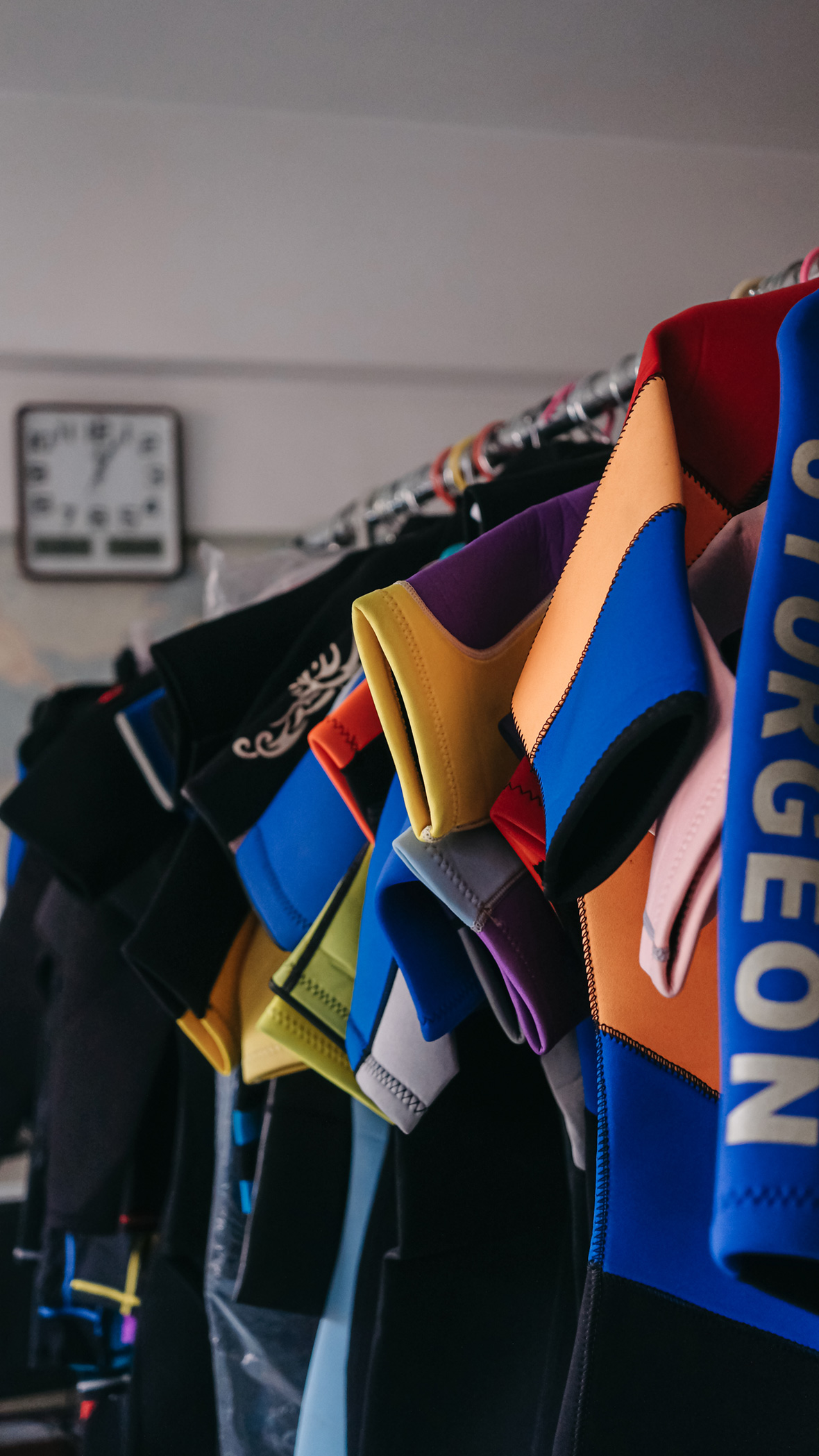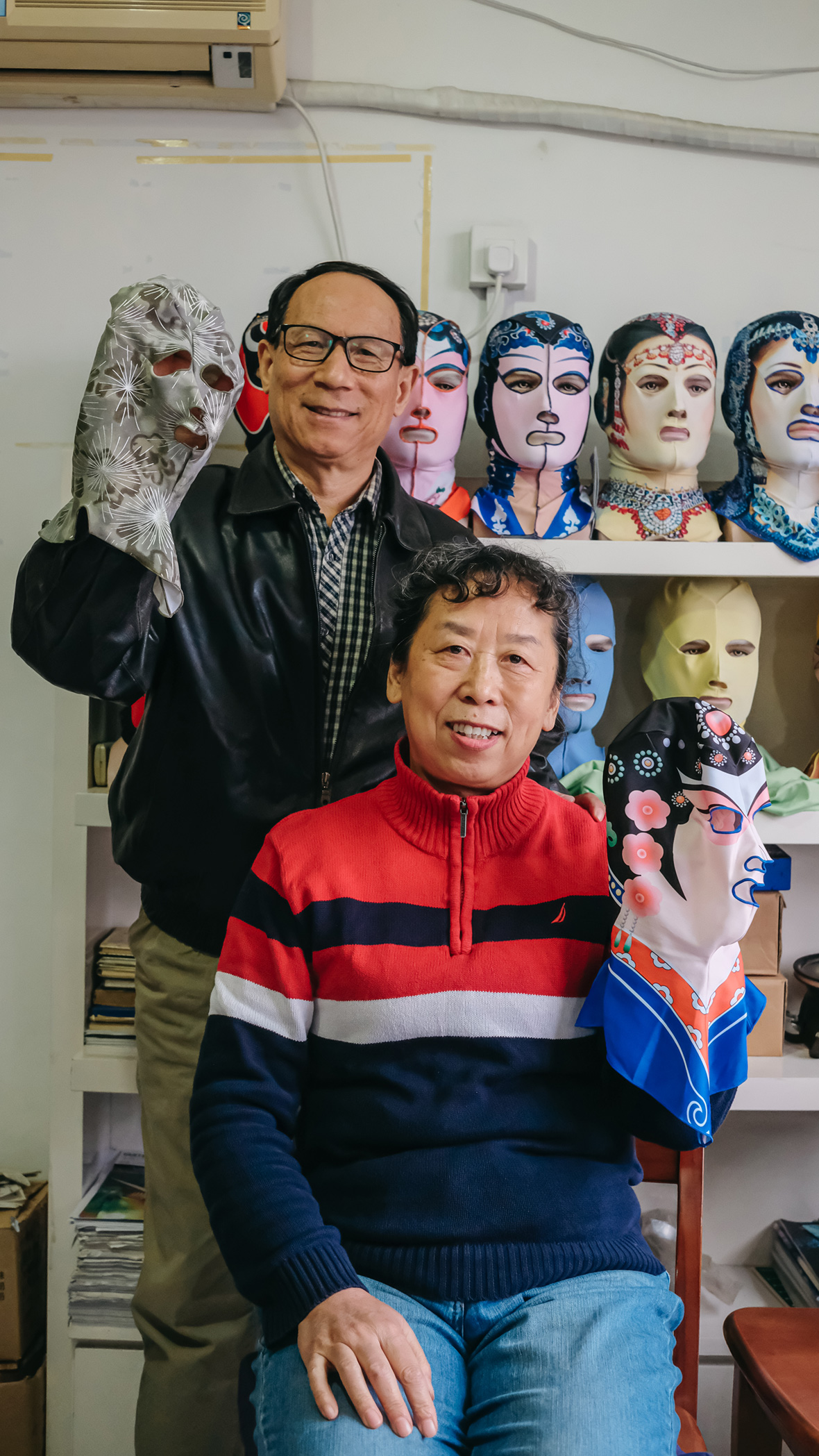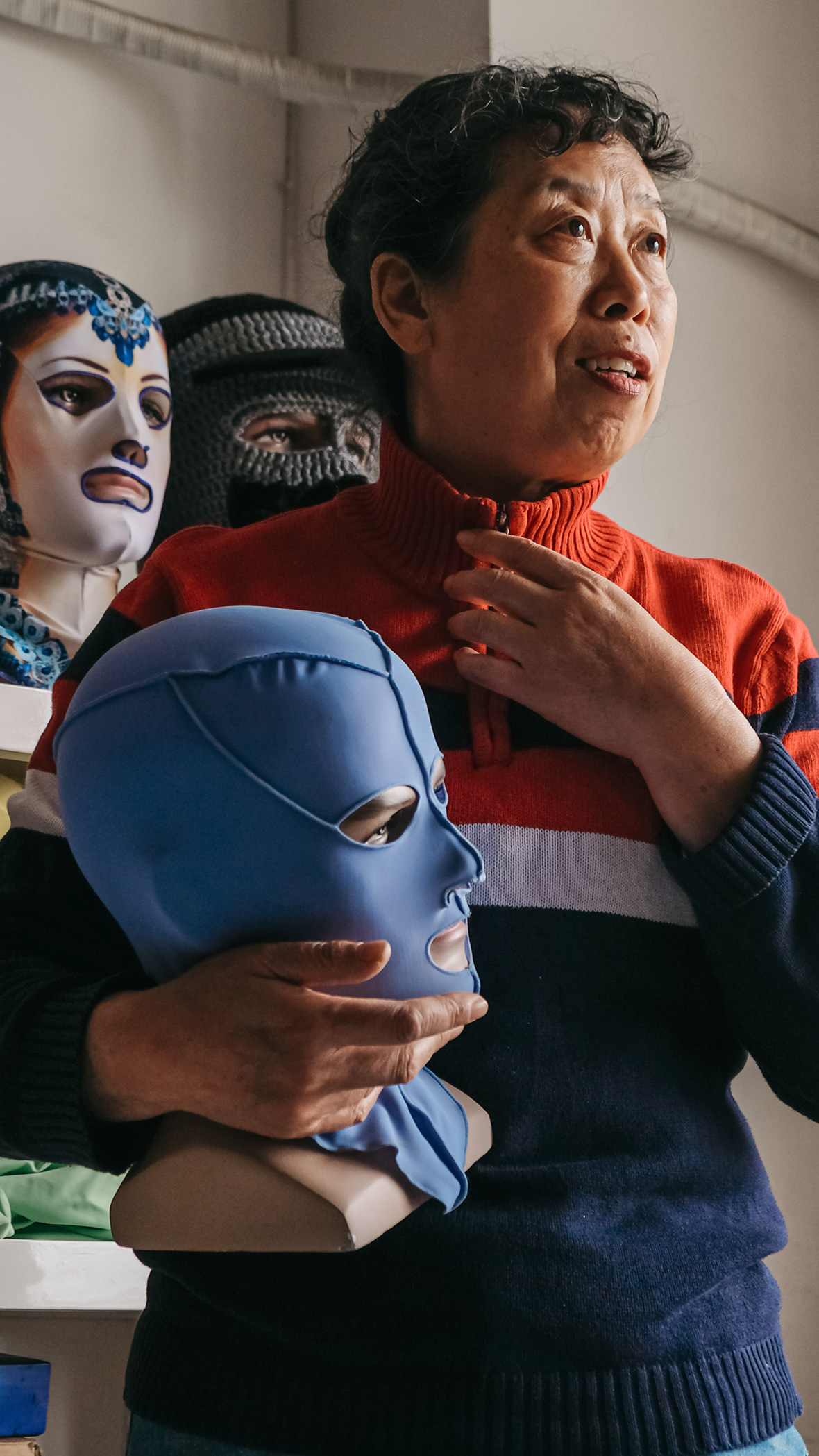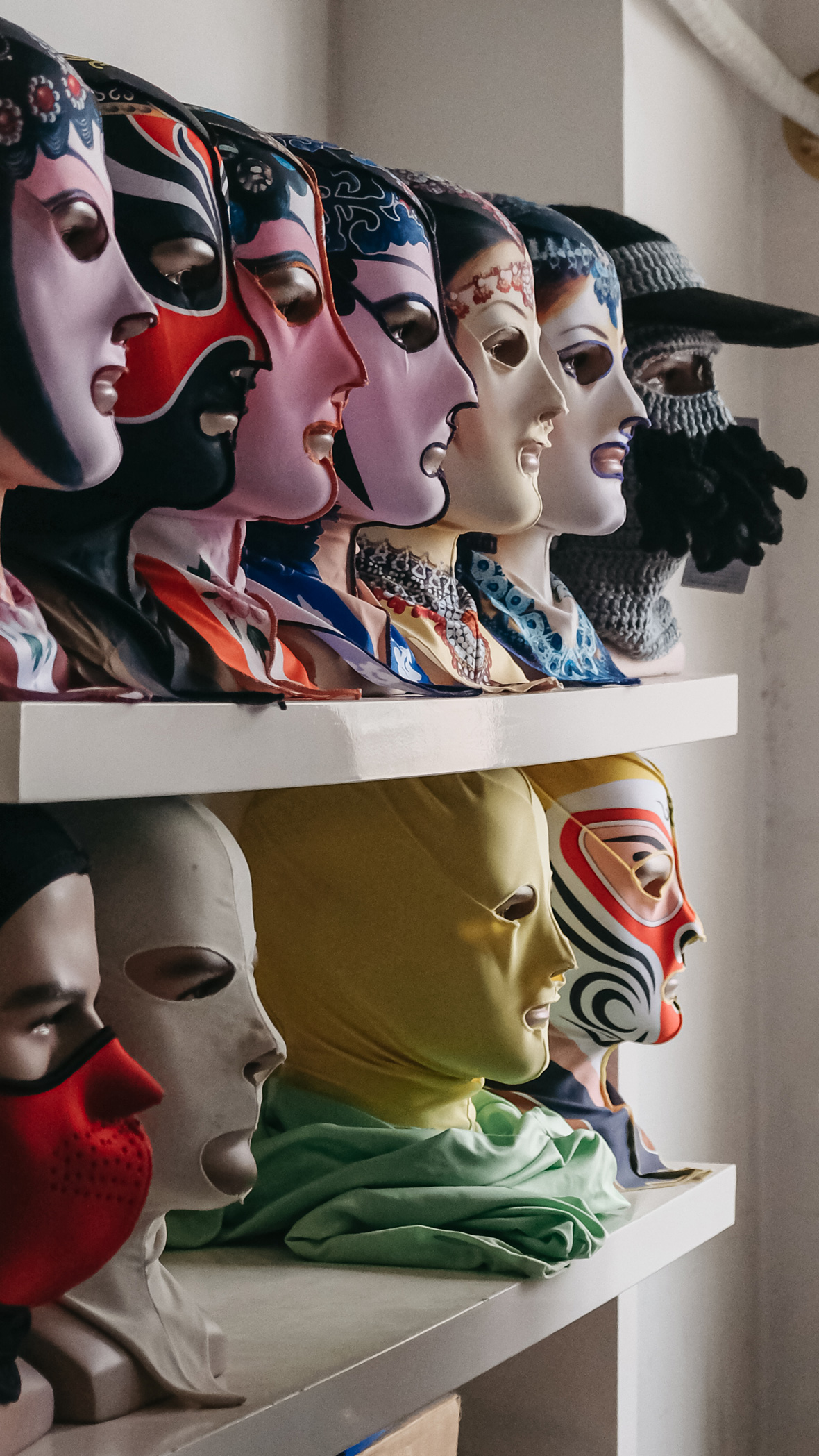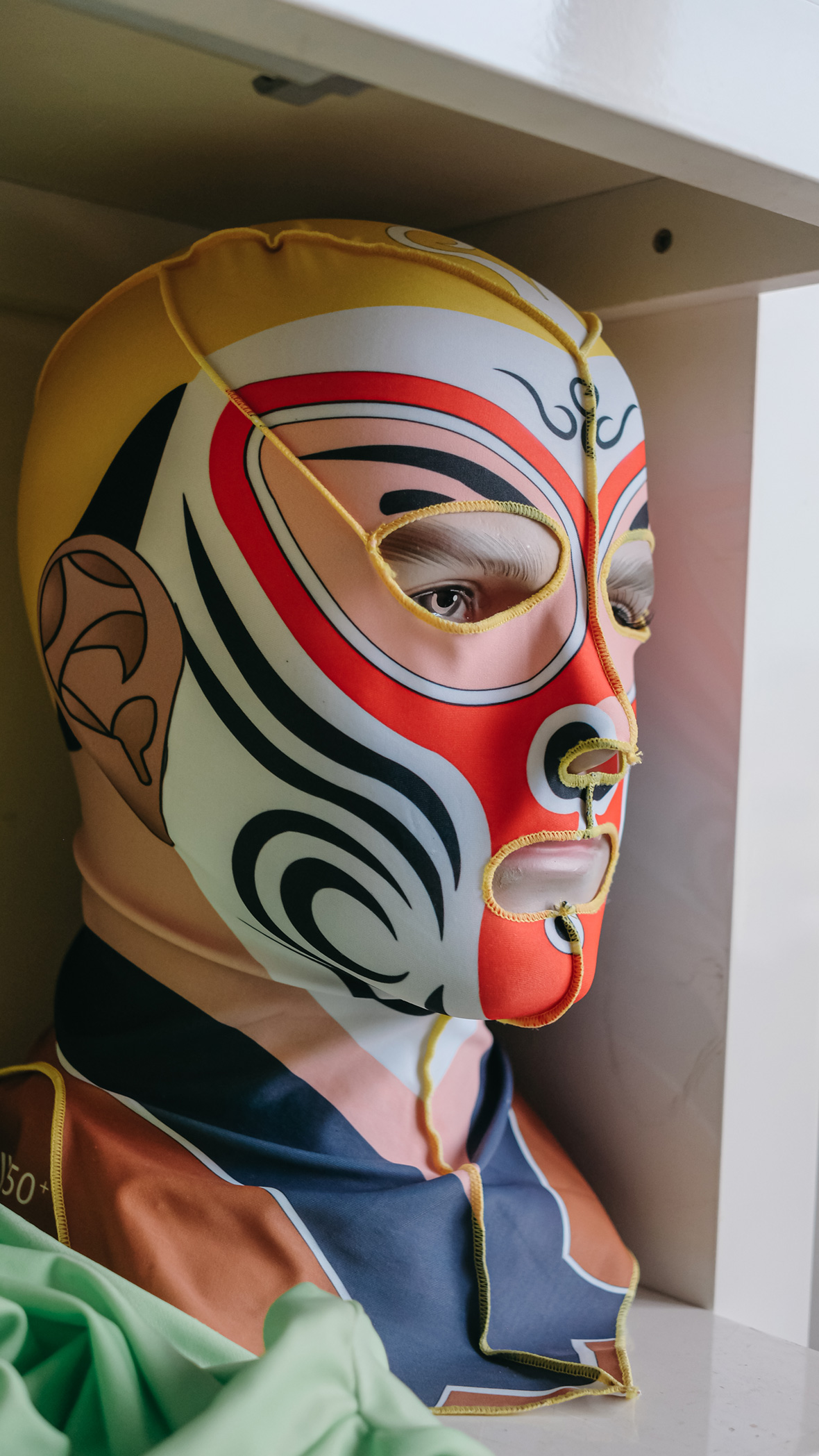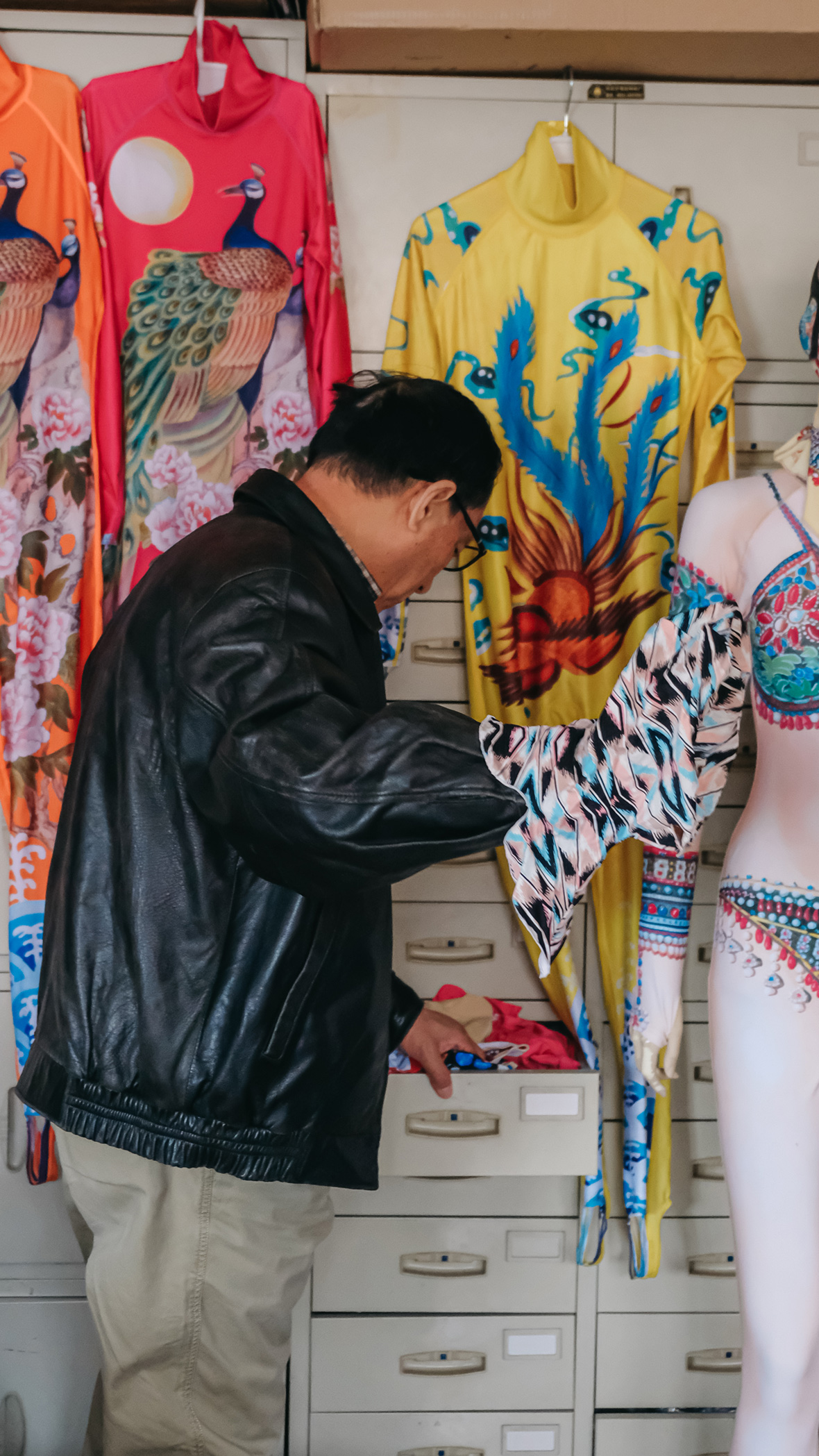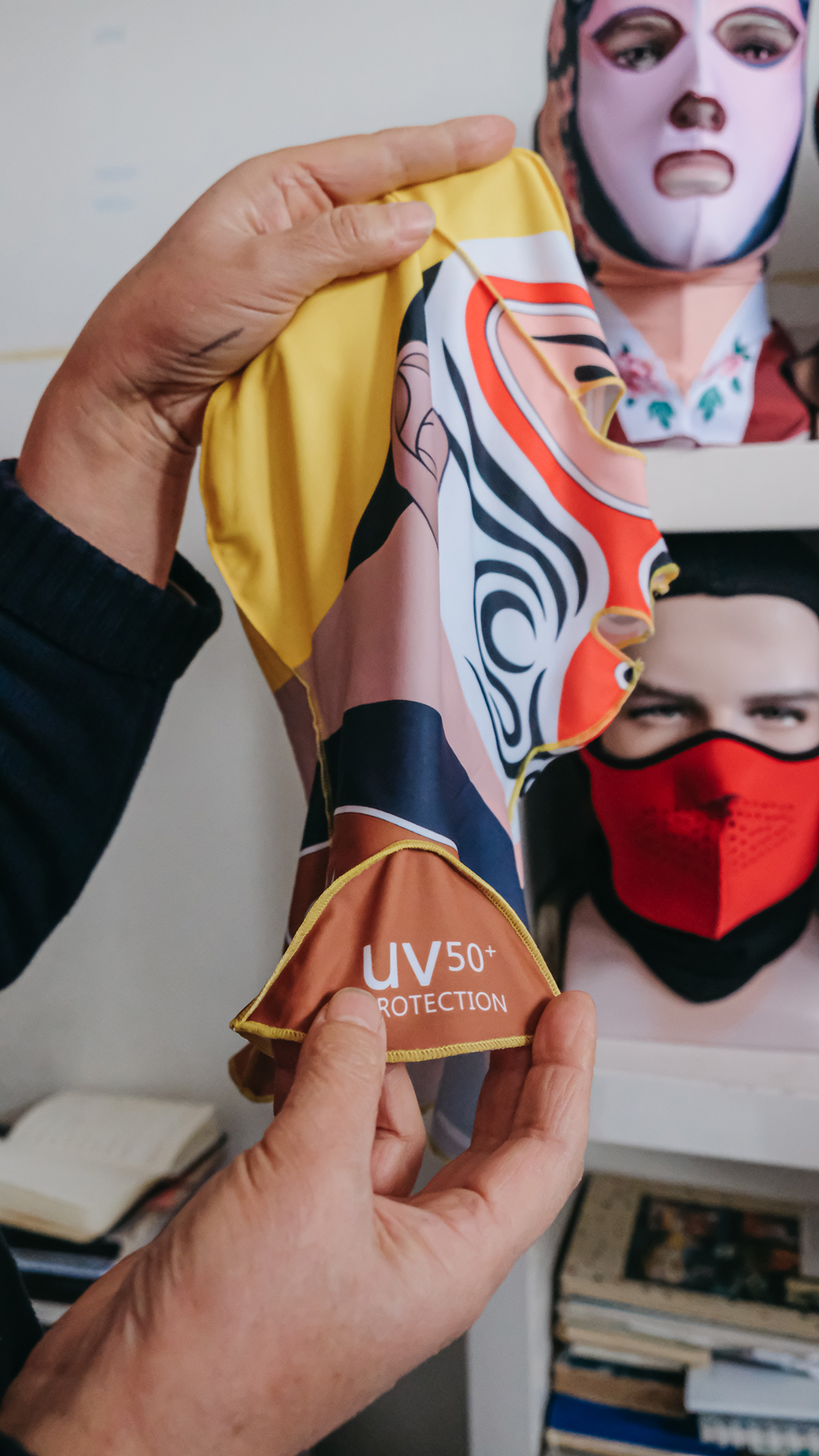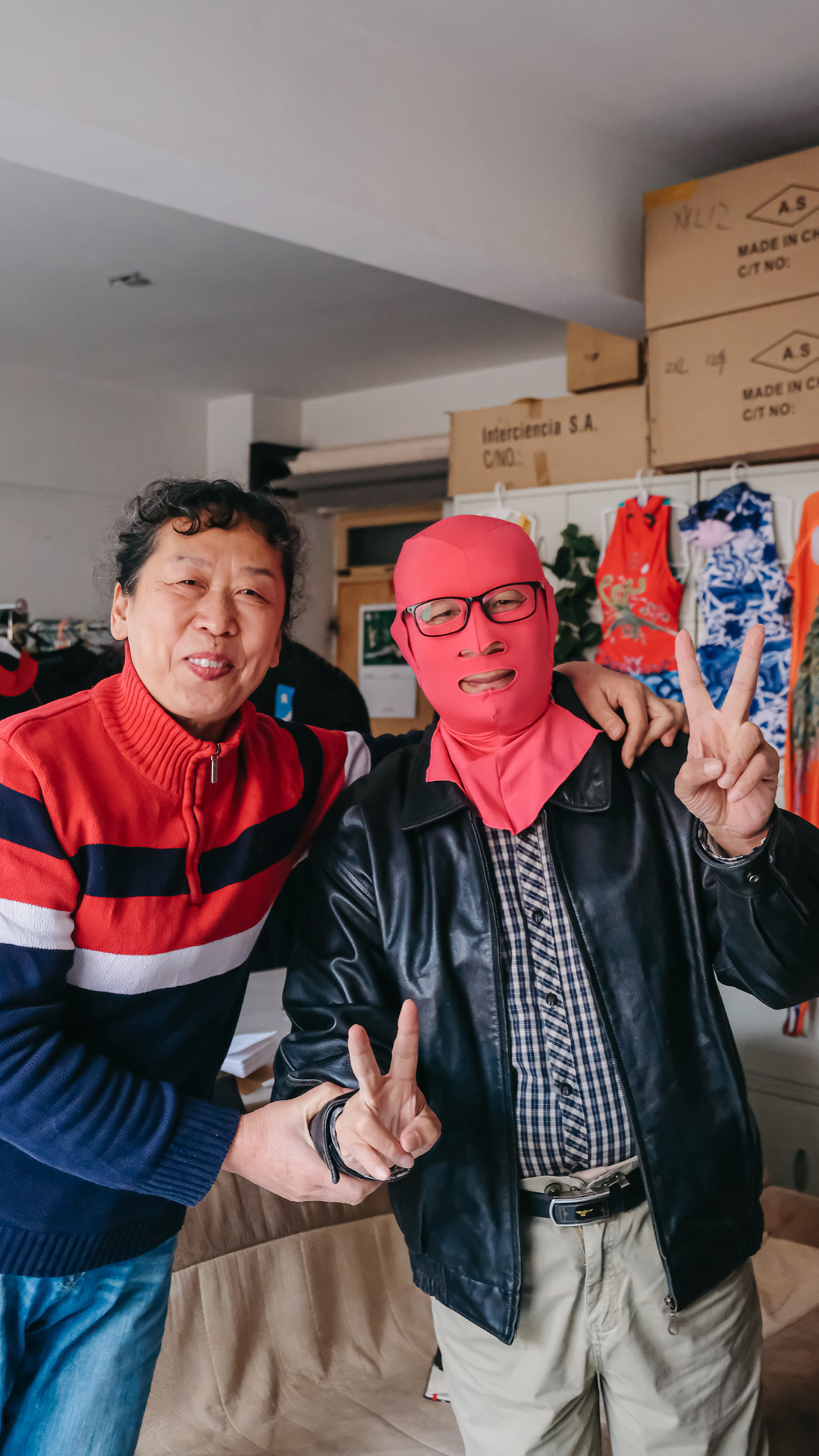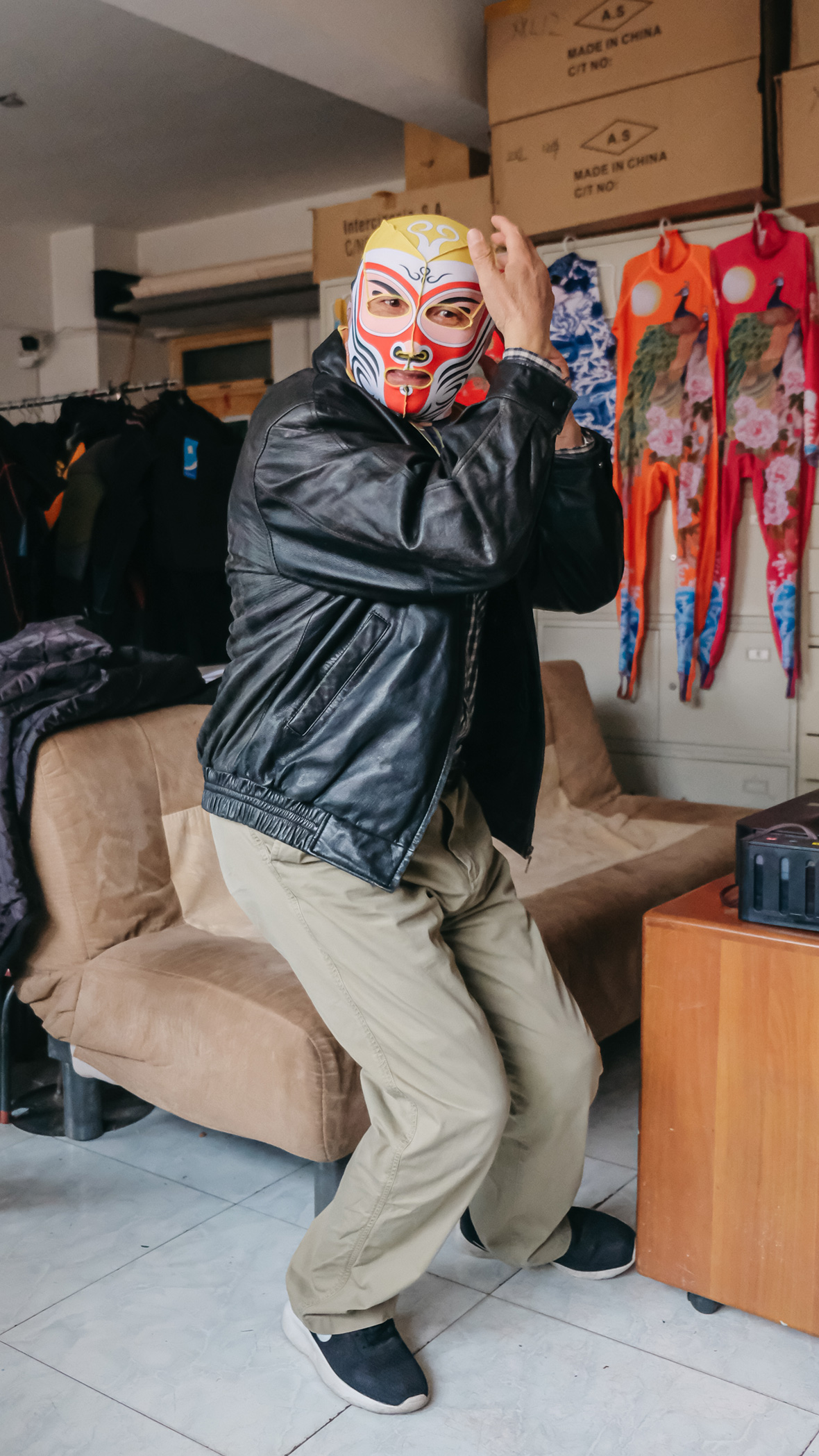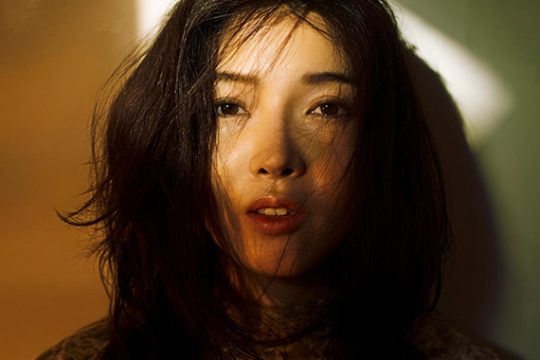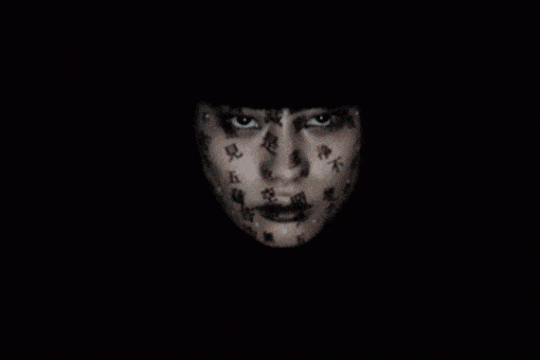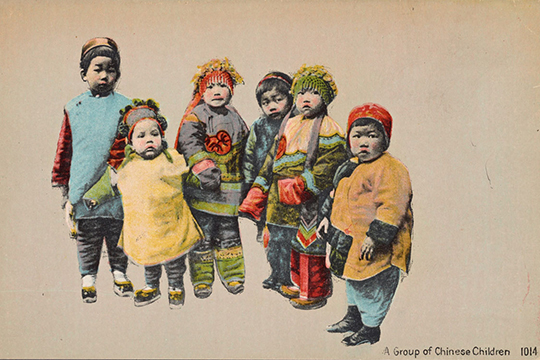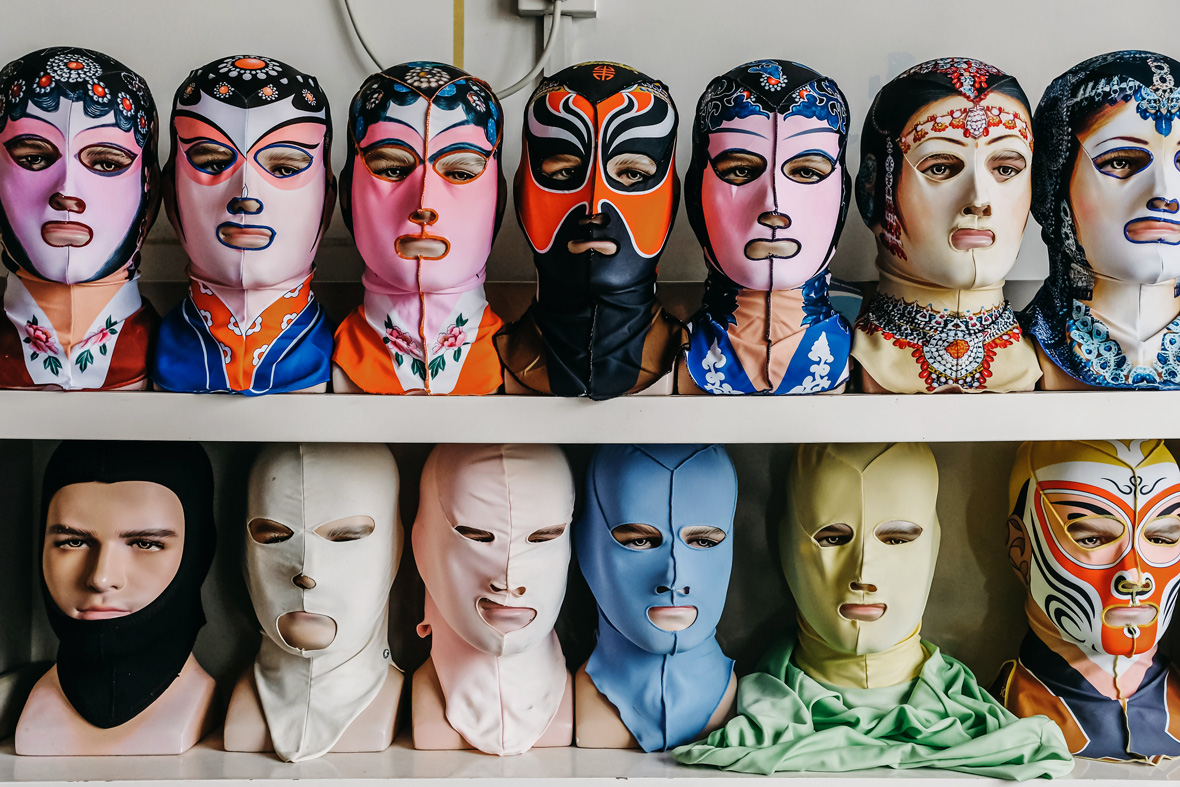
🎧 Listen to this article in Chinese.
Produced in collaboration with BADOU (八斗) — a new app curating premium journalism and storytelling from around the world and narrating it with professional Mandarin Chinese voice actors.
Stepping off the elevator, a handwritten sign with a crudely drawn arrow reads, “Swimsuits, diving suits: pickup area.” A long dark corridor leads us to unit 501, an office space that feels more like a stockroom; it’s cluttered with all sorts of swimwear, boxes, and clothes racks. The Qingdao sea is barely visible through the large window, a slit of water squeezed between buildings on the gray, wintry morning.
We’re greeted by Zhang Shifan and Liu Keliang, a neighborly couple in their seventies and the owners of swimwear brand Sturgeon Dragon. Zhang wears a nondescript sweater and has her hair tied back in a bun. Liu wears a dark brown leather jacket and Nike shoes. He’s the one who began explaining the story of their business when we were barely past the door.
🎧 此文音频与 八斗(BADOU)合作。
八斗, 一款精选国内外优质媒体及作家的纪实文章与故事,并由专业的讲演人用中文为你娓娓道来的APP。
刚踏出电梯,一个标记着箭头的手绘牌子映入眼帘,上面写道:“游泳衣、潜水服存取处”。穿过黑暗的狭长走廊来到 501 室,这里是一间酷似仓库的办公区域:堆满了各式各样的泳装、包装盒和衣架。透过这间屋子的窗户向外望去,依稀能看见青岛边上的黄海,大海在灰蒙蒙的冬日早晨,如同天边的细长水线,穿流于建筑物的缝隙。
迎接我们的是张式范和刘克亮,这对面容亲切的夫妇已有七十多岁,也是“鲟龙”泳装品牌的老板。张式范穿着一件普通的毛衣,头发向后扎成一个发髻;刘克亮则穿着深棕色皮夹克和耐克鞋。刚一进门,刘克亮就开始给我们讲述他们的创业故事。
Seventeen years ago, his wife Zhang invented the facekini, a Lycra swimming mask that starts at the collarbone and covers the entire head, available in several colors and patterns. Because of its unconventional design, Zhang’s invention gained international notoriety, being featured in publications like The New York Times, The Washington Post, and Vogue. Over the years, the facekini became a global curiosity, a fashion statement, and the source of much controversy.
Despite the common belief that it’s a sun-protective mask, the facekini originated from another practical need at the beaches of Qingdao: protection from jellyfish stings. Many species of jellyfish bloom on the Yellow Sea coast, where Qingdao is located, sometimes weighing more than 100 kilograms and ranging up to two meters. As they commonly reach shallow shore waters, they pose a threat to beachgoers.
十七年前,他的妻子张式范在国内开创了“脸基尼”,这是一种有着各种颜色和图案的游泳头套,采用莱卡面料制成,从锁骨开始将用户的整个头部全部包裹住。这种不同寻常的头套引起了世界各地人们的好奇,并相继被《纽约时报》、《华盛顿邮报》和《时尚》等杂志报道。多年来,“脸基尼”成为了火遍全球的新奇玩物,一股另类的时尚潮流,但同时也没少招来争议。
虽然现在人们普遍视其为防晒头套,但“脸基尼”的诞生其实源于人们在青岛海滩的另一种需求:防止海蜇蛰伤。青岛所在的黄海沿岸生活着大量海蜇,有的巨型海蜇甚至重达100多公斤,长达两米。这些海蜇经常在浅岸水域出没,对海滩的游客造成很大的威胁。
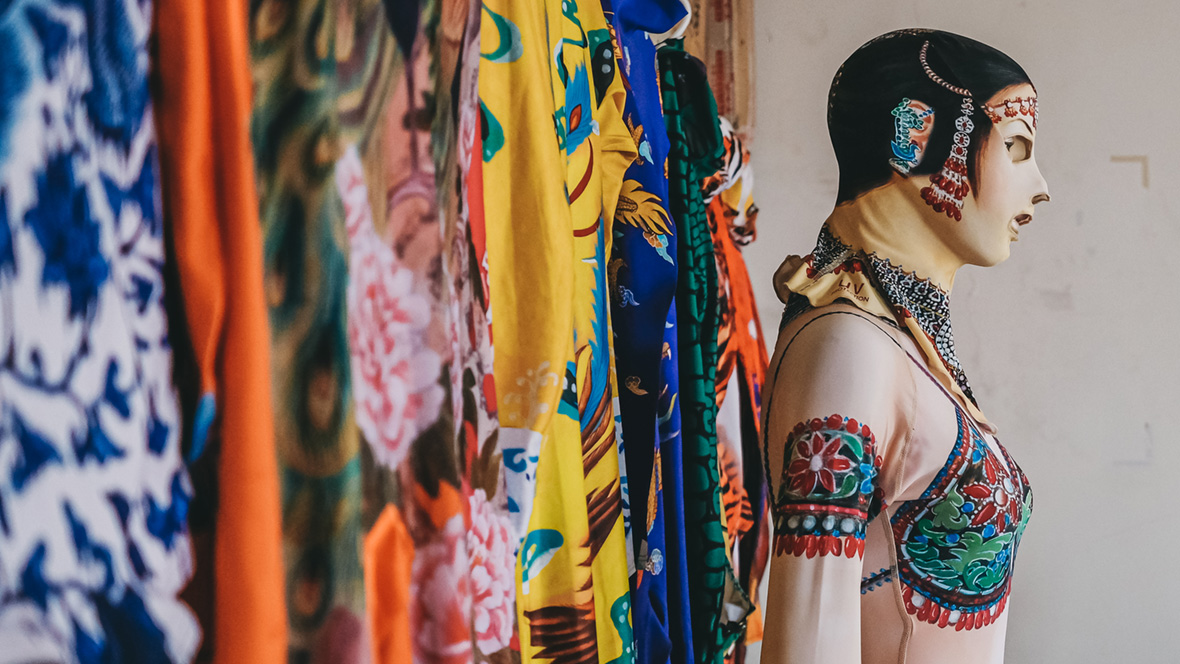
When Zhang was six years old, she witnessed how dangerous these animals can be. Her family lived on a military base and once hosted an army nurse. One day, while training out at sea, the nurse was severely stung by a jellyfish. She was wearing a swimsuit with long sleeves, so her arms and most of her body were protected, but her face and hands swelled up with large red patches.
To this day, Zhang clearly remembers the night that followed the incident. “We took her home for my grandmother to treat her, but she was suffering through the night!” With the cries of the nurse echoing through the night, Zhang couldn’t sleep. “I just remember thinking if only her clothes covered a bit more, she wouldn’t be suffering that much.”
张式范六岁的时候,就曾亲眼见识过这种动物的凶险。当时她随家人住在军事基地,曾接待过一名军队护士。一天,出海训练时,这名护士被一只海蜇蛰伤,伤势严重,由于穿的是长袖泳衣,所以她的手臂和大部分身体都没事,但露出的脸和手却出现了一大片红肿。
直到今天,张式范还清楚记得当晚的情形。“我们带她回家,我奶奶帮她处理了伤口,但她还是整夜痛苦不堪!”张式范一整夜听着护士痛苦的呻吟,难以入睡,“我当时就在想,要是她的泳衣能多盖住一点,她就不会受那么多折磨了。”
Going to the beach was not a big part of Chinese culture until the Europeans arrived. For a brief period, Qingdao fell in the hands of German colonizers as the capital of the Kiautschou Bay concession, and in the early 1900s, they introduced activities such as diving and promenading to the city. Still, the local population rarely took part in them.
Living by the sea, Zhang saw the evolution of beach culture in China. In her childhood, going to the beach revolved around activities such as picnicking or fishing. Swimming was only an afterthought. Beachwear was also uninspiring and conservative at the time. “It was horrible! It was all made of cotton, and the stretching was not good,” she recalls. “After a little while, clothes would look baggy and loose. Colors faded fast, and they would form lint balls.”
Things changed little until the late 1980s when Lycra fabric finally arrived in Qingdao. “Lycra is far more structural. It shapes the body nicely and pushes the breasts up, putting them in the right place,” Zhang says, gesturing with her hands with a spark in the eye. With the introduction of the material, vivid colors and patterns brightened the beaches of Qingdao, making beach culture more commercial and even sensual, opening up the expanding niche of leisurewear.
Around the year 2000, Liu owned a manufacturing company supplying swimwear to brands across the world. He was also an inventor, designing machines for high-resistance training, such as underwater treadmills and bicycles. Once, he was even commissioned to design an underwater bicycle for athletes training for the Tour de France.
其实在过去,当地人并不热衷到海边玩,直到后来德国殖民者占领了以青岛为中心的胶州湾租界,并在1900 年代初在当地引入潜水和海边散步等活动。居民们才渐渐参与到这些海边活动中来。
在海边长大的张式范亲眼目睹了中国海滩文化的演变。童年时,人们去海滩主要是为了野餐或钓鱼,很少人是为了游泳而去海边,当时的沙滩装也很普通和保守。“那时候的沙滩装不堪入目!都是全棉做的,弹力也不好,”她回忆道,“还没穿多久,整件衣服就会松松垮垮,还经常容易掉色、起毛球。”
直到 1980 年代后期,莱卡面料进口青岛,类似的状况才有所改观。“莱卡更具结构感,可以很好地贴合身形并达到提胸的效果,将胸部托高到合适的位置,”张式范边说边用手比划,眼睛仿佛闪烁着火花。这种新面料的出现也让青岛的海滩装有了更多鲜艳的尝试,提升了海滩文化的商业性和魅力,也开辟出休闲沙滩装的小众市场。
大约在 2000 年,刘克亮开了一家制造公司,专门为世界各地的品牌供应泳衣。与此同时,他还是一位发明家,曾设计用于高阻力训练的机器,例如水下跑步机和自行车。有一次,他甚至受委托为环法自行车赛的运动员训练设计了一款水下自行车。
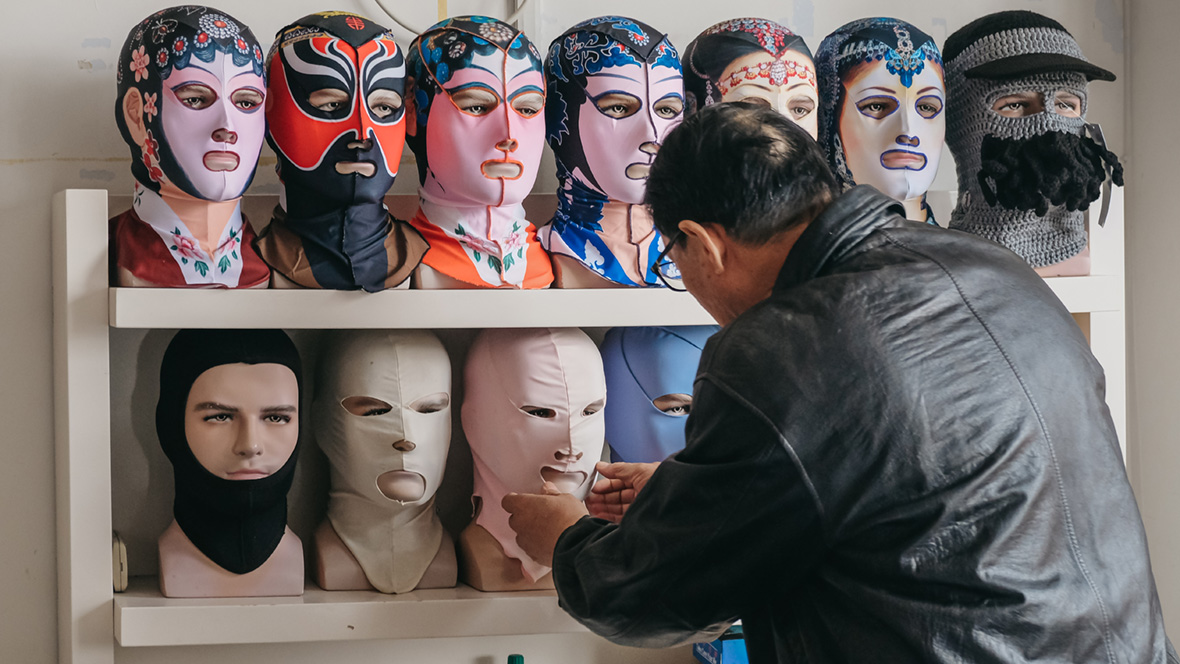
One of Liu’s American buyers, a 73-year-old woman who was the president of a swimwear brand, once visited his manufacturing facilities in China. Zhang, fifty at the time and retired from her accounting job, was fascinated by her, and by the fact that she was running her own successful business on the other side of the world. She suddenly realized that she could do the same. So, with deadstock fabric from Liu’s factory and studying his product catalogs, Zhang began designing her own line of swimwear. She quickly opened a brick-and-mortar shop by the beachfront to cater to the local market. Still, sales were slow at first, and she realized she needed something different to attract new customers.
Zhang noticed that many people who came into her shop shared a common fear. “They were afraid of swimming because of jellyfish! Many of them would even wear long Johns to go into the water. Sometimes they would wear their pajamas. It all looked awful, and uncomfortable to swim.”
Zhang’s first hit was a Lycra wetsuit covering most of the body, exposing only the feet, hands, and head. She and Liu had the idea of printing her telephone number on the back of the wetsuit. The design was dull, unflattering by most people’s standards, but it was surprisingly effective marketing for their business. Zhang’s first customers were like walking—and swimming—advertisements. Her phone never stopped ringing. Her first batch flew off the shelves, and they put her swimwear shop on the map.
Business was going well, and Zhang was happy. But one day, a woman in her forties made a remarkable observation. “You’re doing something right. But only halfway,” she said. Then the woman pointed at her own head. “Our heads are still exposed!” Zhang’s mind went back to the incident with the nurse, and it all clicked.
刘克亮有一位买家来自美国,是一位 73 岁的泳装品牌女总裁,她曾经来中国参观他的工厂。当时 50 岁的张式范刚从会计工作中退休,在与这位事业有成的女总裁接触后深受启发,她突然意识到,自己也可以像对方一样拥有属于自己的品牌。于是,张式范找来刘克亮工厂的滞销面料,研究产品目录,并很快投入到自己的泳装系列设计。随后,她在海滨开了一家实体店,主要卖给当地的顾客。一开始销量并不好,于是她开始思索有新意的电子来吸引新顾客。
张式范注意到,进店的许多顾客都有同样的烦恼——“他们都因为海蜇而惧怕游泳!许多人甚至会穿着秋裤下水,有的人就穿着睡衣,这样不仅不好看,游泳的时候也特别不舒服。”
张式范的第一件作品是一件覆盖大部分身体的莱卡潜水衣,只露出手、脚和头部。她和刘克亮在潜水服背面印上自己的电话号码。这个设计对大多数人来说过于乏味也并不好看,但对他们的业务来说却是一次成功的营销。张式范的第一批顾客成为了他们四处走动和在水里游动的“活招牌”。她的电话响个不停。第一批产品很快就卖光了,她的泳装店也因此在当地小有名气。
店里生意蒸蒸日上,张式范很是开心。直到有一天,一位 40 多岁的女顾客一语中的:“你的泳装设计不错,但还差一点,”她边说着边指了指自己的脑袋,“因为我们的头还露在外面呢!”这句话让张式范想到了童年时期护士受伤的那件事,她由此又灵机一动。
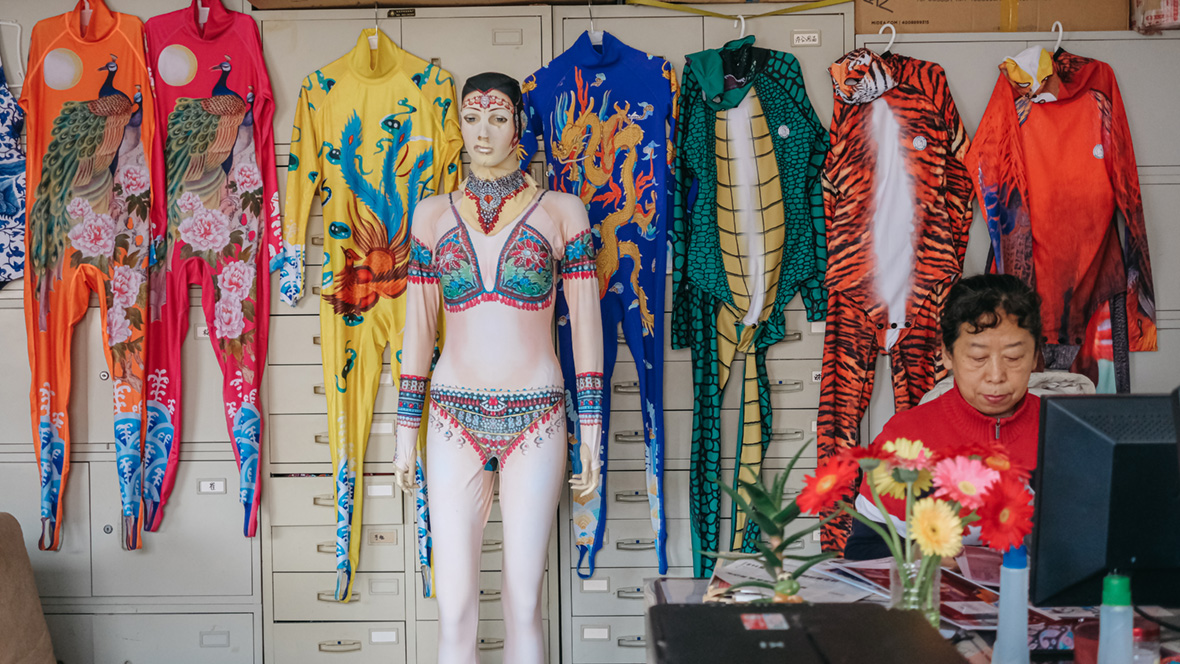
In 2004, the facekini was born. It was an extra layer of protection for the most important part of the human body: the head. Zhang studied ski masks and diving masks to develop a concept of a Lycra headgear that was suitable for swimming, and she spent years perfecting it. Today, different generations of facekini prototypes are neatly displayed in a corner of Zhang and Liu’s office.
These two designs are clearly the most cherished in the couple’s collection. They’ve even worked to create unique prints commissioned from local artists. Like the bodysuit, the facekini was first produced in plain colors, but over time they began including human features, such as eyebrows and hair. More intricate patterns also began appearing, many of which pay tribute to Chinese folklore and traditions, such as Peking Opera masks. An all-time favorite is a theme that takes inspiration from Uygur dancing costumes, featuring dangling gemstones as printed headpieces. It fills Zhang with pride. There’s also a collection themed after endangered animals that combines the facekini and bodysuit in one single piece.
The functional design of the facekini also evolved with time. Each summer, Zhang improved the product based on her observations and the feedback she received from her now loyal customers. For instance, the first generation only had four holes; two for the eyes, one for the nose, and one for the mouth. But then she added extra holes, including one to stick a ponytail out and two for the ears to fasten goggles and hold sunglasses.
When a huge public swimming pool opened in Qingdao, Zhang saw the demand for facekinis increase exponentially. It was only then that she realized that her invention had a multifunctional purpose. “People also like it because it protects them from the harmful rays of the sun. It’s just like wearing a hat—but this one doesn’t blow off in the wind.”
2004 年,“脸基尼”诞生,这款头罩专为保护人体最重要的部位——头部而设计。张式范在研究了滑雪面罩和潜水面罩之后,推出一款适合游泳的莱卡头罩,并花了几年功夫去完善设计。今天,在张式范和刘克亮办公室的一角,可以看到一排“脸基尼”的迭代设计。
其中有两款设计在这对夫妇眼中如视珍宝,他们甚至委托当地艺术家创作了独特的印花。与紧身泳衣一样,脸基尼最初只有单色设计,后来,他们又增加了人脸的五官特征设计,例如眉毛和头发。紧接着,又出现了更为复杂的图案,不乏以中国民间传说和传统文化为灵感设计的图案,例如京剧脸谱。最受居民喜爱的设计主题是以维吾尔族舞蹈服装为灵感的设计,以悬挂的宝石作为印花头饰,这是张式范引以为豪的作品;另外还有一个以濒危动物为主题的系列,包括全身一套的脸基尼和紧身泳衣,组成动物的图样。
脸基尼的功能性设计也在不断演变。每年夏天,张式范都会根据自己的观察和顾客的反馈来改进产品。比如第一代的脸基尼只有四个孔;两个是眼睛,一个是鼻子,一个是嘴巴。后来她又加多了几个孔,一个用于拿出马尾辫,两个是耳朵,以方便佩戴护目镜和太阳眼镜。
当青岛一个大型公共浴场开业时,张式范的脸基尼销量迅速上涨,那时她才意识到,她所发明的这个头套还有更多的用途。“很多人喜欢戴它是因为它能防晒,就像戴帽子一样,不同的是,它不会像帽子被风吹掉。”
Unlike Western countries, suntanning is a developing practice in China, one that’s only recently gained momentum with the establishment of Hainan as a holiday destination and interest in surf culture. While more and more young Chinese aspire for bronzed skin as a symbol of a healthy and free-spirited life, it’s a distinctly different ideal of beauty for most of the population in China. Traditionally, not just in China, but in East Asia at large, pale skin is associated with a higher social status, while tanned skin associates an individual with working in the field, under the sun. Hence, mainly for women, white skin is still very much idealized as a standard of beauty.
Most of Zhang’s customers are middle-aged women living in the coastal cities of China who are keen on keeping their skin porcelain-white. It’s not unusual to see them at the beach with umbrellas, shawls, and hats—or in face-covering and head-to-toe designs that evoke imagery of Leigh Bowery—to protect from the sun. They’ve been flaunting their style on the beaches of Qingdao for several years with their facekinis, but they only caught media attention in 2012, when photos of the attire went viral. Shortly after, The New York Times published a front-page story about the surging trend in Qingdao, but the article didn’t mention Zhang, Liu, or their invention.
不同于西方国家,日光浴在中国并不流行,直到近年来,随着海南成为热门度假胜地以及冲浪文化的兴起,才慢慢有更多人喜欢上日光浴。虽然有越来越多中国年轻人将古铜色肌肤视为健康、自由生活的象征,但大多数中国人还是“以白为美”。不仅是在中国,其实在整个东亚地区,人们往往会将白皙的肤色与较高的社会地位联系起来,而黝黑的肤色则通常与日晒雨淋的户外工作联系,因此,“以白为美”仍然是主流的审美标准,尤其是对女性来说。
张式范的顾客大多是生活在中国沿海城市的中年女性,她们热衷于美白肌肤。在海滩上,她们总是想方设法来防晒——撑着遮阳伞,戴上披肩和帽子,或者穿上从头裹到脚的服装,看上去颇有先锋艺术家 Leigh Bowery(雷夫·波维瑞)的风格。其实,她们在青岛海滩上戴脸基尼已经有好几年,但直到 2012 年,当她们这身造型的照片在网上疯传时才引起媒体的关注。很快,《纽约时报》就在头版刊登了关于这股青岛另类潮流的报道,但整篇文章并未提及张式范、刘克亮和他们的发明。
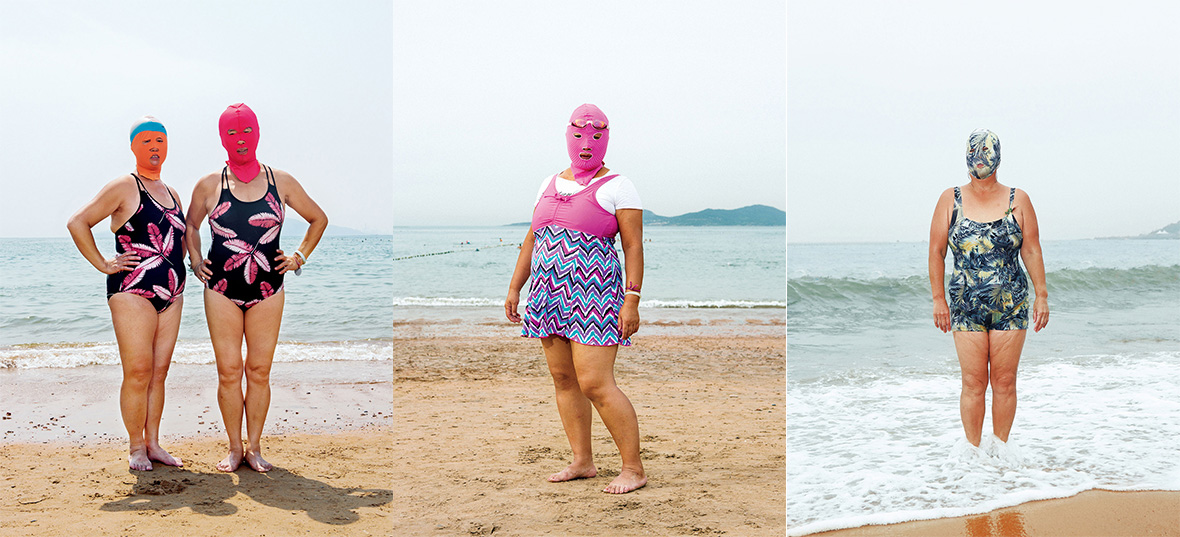
In 2014, there was a furor in the fashion world when Carine Roitfeld, the former editor-in-chief of Vogue Paris, ran a piece featuring models wearing designer swimsuits and facekinis in her own biannual magazine, the CR Fashion Book. The piece shocked most fashionistas, for they thought Roitfeld was endorsing the Chinese trend. If only they had actually read the editorial, they would have known that her intention was to highlight the opposing ideals of beauty and the contrast between East and West regarding tanning practices—raising no judgments. “In Asia […] a tan does not signify a chic trip to Capri, but it could mean hours of hard labor spent out in the harsh sun,” she wrote.
By then, countless international magazines had already reached out to Zhang and Liu for interviews. Zhang, however, was always hesitant in drawing too much attention to herself. She refused all interview requests until a close friend told her she had to take credit for her invention. She finally gave her first interview to a German magazine. Liu still has their cold email in his mailbox, which he shows to us on a dated desktop computer.
2014 年,当时巴黎版《Vogue》杂志前主编 Carine Roitfeld 在自己的半年刊杂志《CR Fashion Book》上刊登了一篇文章,发布了模特穿着设计师泳衣和脸基尼的照片。这篇文章一经发表,就在时尚界掀起轩然大波。许多时尚界人士大为震惊,因为他们认为 Carine 是在支持这股中国潮流。但如果他们真的认真读完这篇文章,他们就会知道,Carine 的意图只是强调不同的审美以及东西方对于“美丽肤色”的见仁见智。“在亚洲,人们看到深肤色并不会联想到一趟远赴卡普里岛的时髦旅行,只会联想烈日下艰苦劳作的人民,”她在文中这样写道。
从那时起,许多国际杂志开始联系张式范和刘克亮进行采访。然而,张式范一直都不喜欢成为被关注的焦点,于是她拒绝了所有采访请求,直到一位好友劝她通过采访申明自己作为发明者的立场,于是,她终于接受了一家德国杂志的采访。刘克亮的邮箱里至今仍然保存着对方发来的邀请邮件,他打开一台陈旧的台式电脑,向我们展示了这些电子邮件。
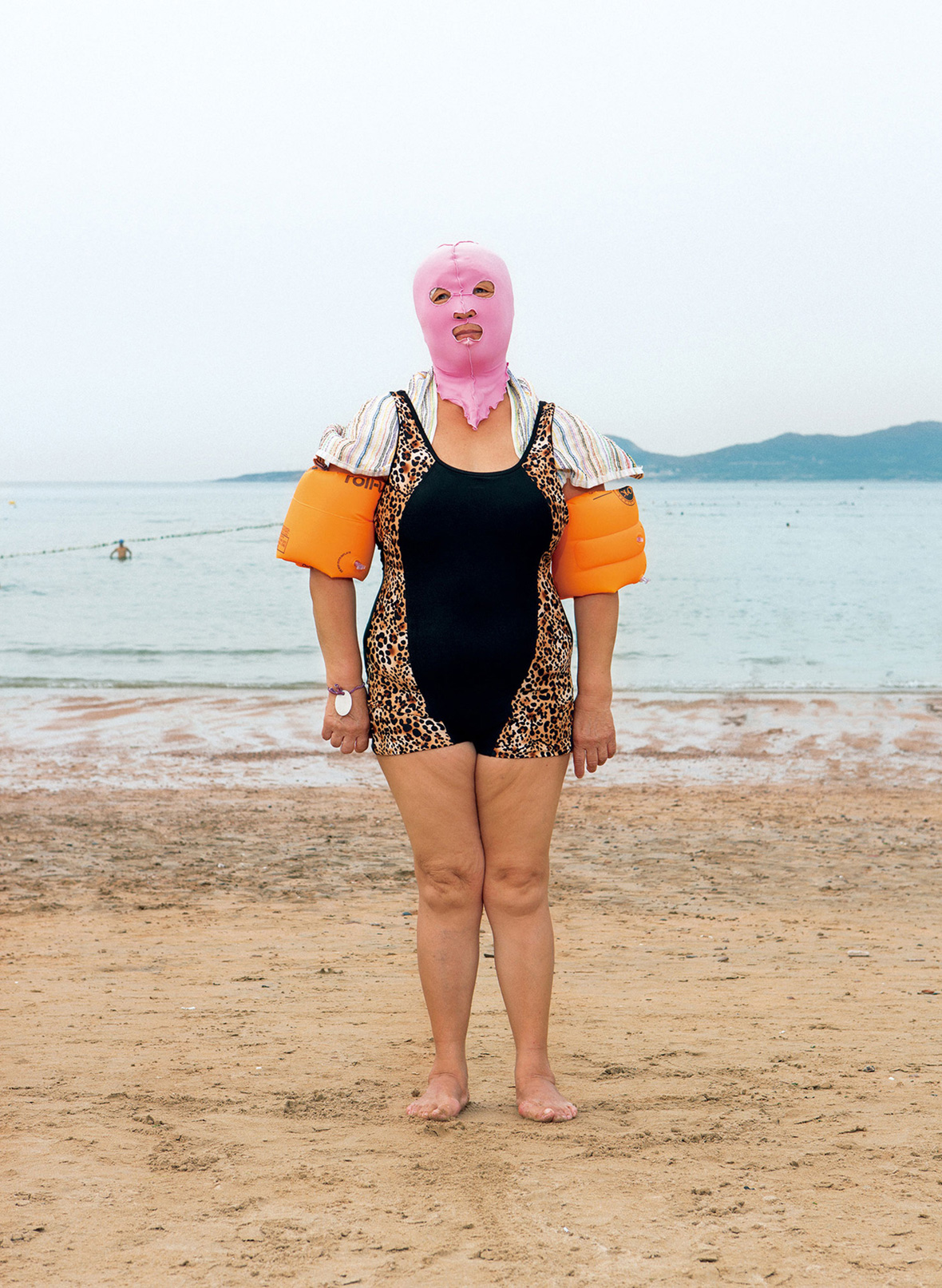

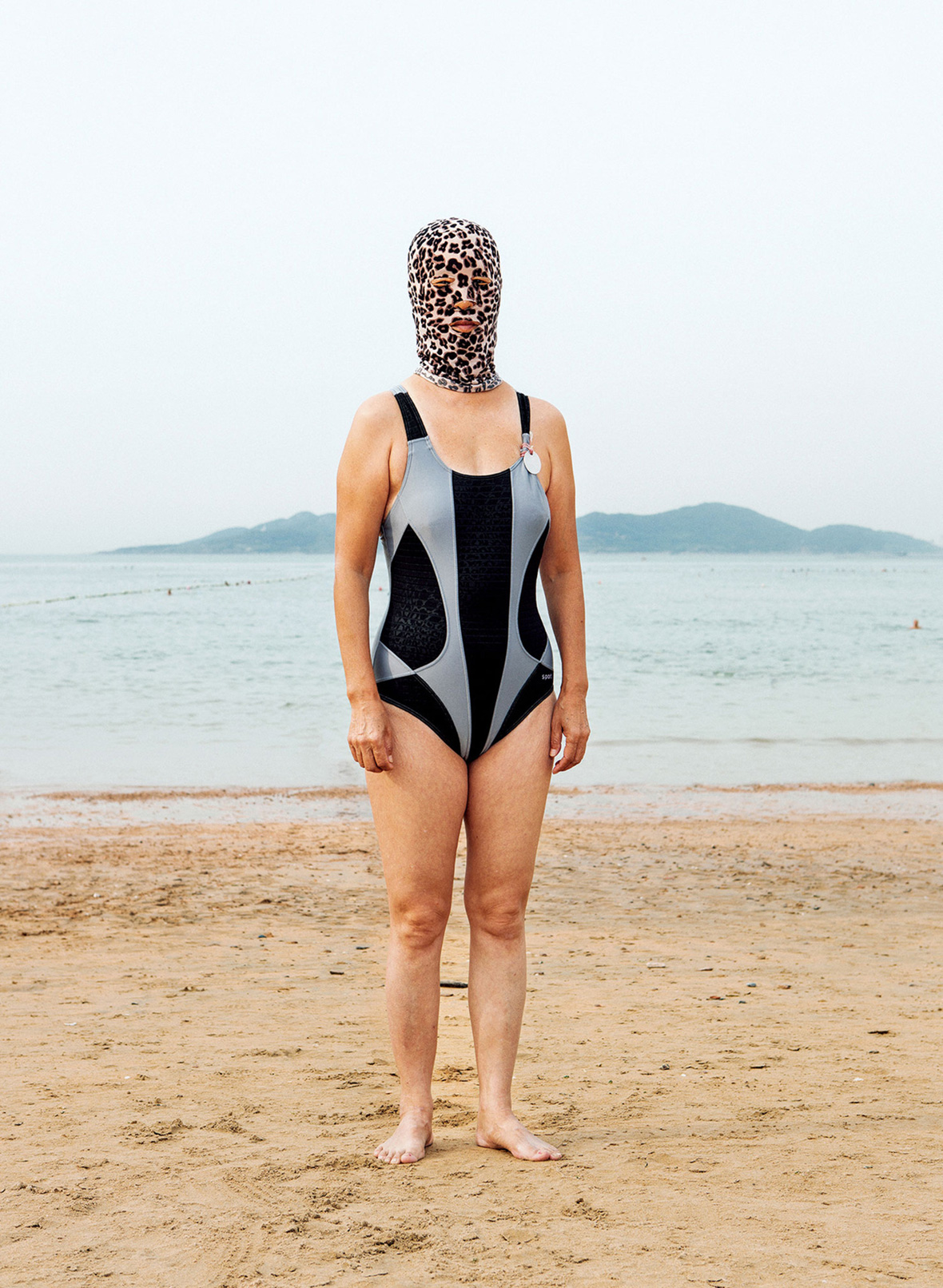

Ever since, they’ve given interviews to more magazines than they can remember. Zhang shows us the clippings of many articles about the facekini. As we flip through them, we see pieces in Japanese, Russian, Arabic, English, and what seem to be Swedish at a quick glance. It was the media that gave the facekini its famous name. Before, the product was simply called “face protector,” but the public fell for the buzzword in China and abroad. Nowadays, the term even appears in online dictionaries as a countable noun.
However, many of these publications didn’t feature Zhang’s facekinis. They featured copies with different patterns and structural designs. In fact, an American business executive copycatted the facekini and trademarked the name in the United States in 2013, right after it went viral. He was even interviewed by Inc. magazine. All this prompted Zhang and Liu to protect their concept legally, but there’s little they can do in international waters.
Also, as the facekini became a media phenomenon, mockery set the tone. The new product and Chinese beach culture at large came under the scrutiny of tendentious journalists. The facekini was a “terrifying trend,” a “Halloween prop,” a “hip of horror.” Some said that “bandit masks invaded the beach” and that the facekini was “fashion’s worst trip to the beach yet.”
Zhang remained oblivious to it all until the day she learned that a photograph of a Qingdao beachgoer wearing one of her designs appeared as part of a selection of shocking photos in an American magazine. Right next to it, a picture of the 9/11 terrorist attacks. “Of course, I had heard occasional comments about the way the facekini looked. And there were some isolated incidents of children getting frightened at the beach. But I always worked on my designs to keep them away from any negative associations, and I always thought of the facekini as something good, made to protect people. It was disturbing to me to see it related to something so negative.”
China also joined the international frenzy. Chinese netizens went wild with comparisons between the facekini and the burkini, especially when the latter was banned in some resort towns in the French riviera in 2016. Jokingly or not, there were calls for a ban of facekini on the basis that it could help the ill-intentioned conceal their identities.
Zhang found the accusations and comparisons preposterous. She says there’s nothing intrinsically evil about her invention. As with many other things, it’s how people use it that determines whether it’s harmful or not. She also says that the facekini is not religious nor mandatory. “You wear it if you want, and for whatever reason you want.” Still, she had to stay away from the internet for quite some time to avoid getting upset.
Despite the widespread obsession with the facekini, face-covering masks are nothing new. Balaclavas, for instance, were already worn by police, the Pussy Riot members, Mexican wrestlers, and fetishists alike. In parts of Southeast Asia, construction workers and motor cyclists commonly wear full-head accessories to shield themselves from the scorching sun. Still, Zhang was the one to re-imagine the accessory as a wearable device away from the purpose of concealing one’s identity and to make it both protective and fashionable.
Not to say that the international exposure did not benefit her business. She now exports facekinis to Japan, Australia, the United States, and England. She sells it to almost all Chinese provinces, including places far away from the coast, because some customers also like to wear facekinis to go jogging or trekking. Her company with Liu, Sturgeon Dragon, has about ten employees spanning product development, customer service, and logistics. Zhang is the inventor and lead designer, while Liu is more focused on the business, marketing, and public relations side. They’ve worked together for over twenty years, seventeen of those perfecting the facekini, a product that represents at least ninety percent of their business revenue.
从那以后,他们又陆续接受了许多杂志的采访。张式范向我们展示了这些关于脸基尼的文章剪报,里面有日语、俄语、阿拉伯语、英语还有像瑞典语的报道,“脸基尼”(facekini)这个名字也是媒体所起的,在这之前,他们只是简单称之为“护脸泳装”。现在,“脸基尼”(facekini)已经成为国内外的流行语,甚至被收编到在线词典中。
然而,这些报道里所出现的照片大多都不是张式范设计的脸基尼,而是不同图案和结构设计的仿制品。脸基尼火了之后,2013 年,一位美国企业家抄袭了脸基尼,并在美国注册了商标,甚至因此接受了《Inc.》杂志的采访。这一切也促使张式范和刘克亮用法律手段来保护自己的设计,但对于海外的仿制者,两位老夫妻也望尘莫及。
基尼在备受媒体关注的同时,也不乏嘲笑的声音。这种新奇的设计和中国的海滩文化受到了一些带偏见的记者的攻击,称脸基尼是“可怕的潮流”、“万圣节道具”和“恐怖时尚”,还有人说这是“强盗面具入侵了海滩”,脸基尼是“迄今为止最糟糕的沙滩设计”等等。
对于这些评论,张式范原本一无所知,直到有一天,她看到一本美国杂志评选的令人震惊的照片系列中,有一张人们头戴脸基尼出现在青岛海滩的照片,而在这张照片的旁边是一张拍摄于 9/11 恐怖袭击的照片。“我当然也会听到别人对脸基尼的评价,偶尔也听说过有孩子在海滩上看到脸基尼受到了惊吓。但我一直在努力改进我的设计,尽量让它们看起来没有什么负面联想,我一直觉得脸基尼是一个有益的设计,用来保护人们,所以看到有人将它和其他负面的东西联系起来,实在让我感觉很难过。”
在中国,关于脸基尼的争议也不少,一些中国网民也将脸基尼和穆斯林泳衣“布基尼”(burkini) 相提并论,而在 2016 年,法国里维埃拉一些度假小镇禁止了在海滩穿布基尼。于是,有人半开玩笑地呼吁禁止配戴脸基尼,理由是怕有不怀好意的人藉此隐藏身份。
张式范认为这些指责和比较荒谬至极。她表示,她在发明脸基尼时并没有任何不好的意图,和许多事物一样,事物的好坏取决于人们如何使用它。她还表示,脸基尼跟宗教无关,也没有任何强制性。“你想怎么穿就怎么穿。”虽说如此,为了不被网上的评论影响心情,她还是选择了暂时远离互联网一段时间。
尽管脸基尼掀起了一股潮流,但其实这种头套并非什么新鲜事物,例如警察、俄罗斯乐队 Pussy Riot、墨西哥摔跤手和恋物癖者都喜欢佩戴的巴拉克拉法帽(Balaclavas);在东南亚部分地区,建筑工人和摩托车手也常常会戴头套来遮挡烈日。而张式范则将这种原本用于掩藏身份的配件重新设计成可穿戴性的配饰,使其既具有保护作用又富有时尚感。
当然,在国际社会获得的曝光度对她的业务也并非毫无好处。她的脸基尼现在除了出口到日本、澳大利亚、美国和英国,也销往中国几乎所有省份,包括远离海岸的地方,因为有些顾客也喜欢穿着脸基尼慢跑或徒步。她和刘克亮创立的鲟龙品牌现在大约有 10 名员工,分别负责产品开发、客户服务和物流方面的工作。张式范是发明者和首席设计师,而刘克亮更专注于商业、营销和公关方面的工作。两人已经一起工作了 20 多年,其中 17 年都在不断改进脸基尼的设计,这款产品至少占了他们业务收入的 90%。
Still, the facekini is far from being a major Chinese fashion trend. It doesn’t appear in the covers of fashion magazines, local celebrities do not wear it, and it was never really voguish, despite being featured in Vogue. It’s merely a very successful niche product with a defined and captive audience, born from the entrepreneurial spirit of a woman who, in her golden years and with the support of her husband, followed a dream.
As we end our conversation, Liu puts on a facekini mask themed after the legendary Monkey King. We ask him if it’s comfortable to wear, but instead of answering, he stages a dramatic performance of a Peking opera, right there for us, singing and gesturing vigorously. Zhang finds it all hilarious. As we prepare our camera and pull out our phones to capture the moment, she rushes across the room to be next to him, bearing a radiant smile. Beyond the mask, this bond is the formula of their success.
尽管如此,脸基尼在中国还远未称得上是主流的时尚文化,从未登过时尚杂志封面,也没有本地名人戴过,更从未被归类为时尚,虽然它确实被《Vogue》杂志刊登过。脸基尼只能算是一个成功的小众产品,有明确的受众群体,源于一位有着创业精神和勇于追求梦想的女性,和她身后那位不断给予支持的丈夫。
采访结束时,刘克亮戴上了孙悟空脸基尼。我们问他戴起来舒不舒服,他没有回答,而是当场给我们活灵活现地表演了一段京剧,张式范在一旁边看边笑。当我们拿起相机和手机,准备捕捉这一刻时,她跑到了他身边,脸上洋溢着灿烂的笑容。在那脸基尼头套之下,两人的亲密情感或许正是他们成功的秘诀。
Like our stories? Follow us on Facebook and Instagram.
Contributors: Tomas Pinheiro, Daecan Tee
Photographer: Mae Szeto
Chinese Translation: Olivia Li
Additional Images Courtesy of Peng Yangjun
供稿人: Tomas Pinheiro, Daecan Tee
摄影师: Mae Szeto
英译中: Olivia Li
附加图片由 Peng Yangjun 提供

